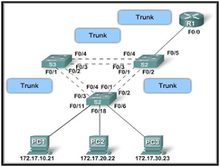Router on a stick
In computing, a router on a stick, also known as a one-armed router, is a router that has a single physical or logical connection to a network. It is often used to forward traffic between locally attached hosts on separate logical routing domains or to facilitate routing table administration, distribution and relay.

Details
One-armed routers that perform traffic forwarding are often implemented on virtual local area networks (VLANs). They would use a single Ethernet network interface port that is part of two or more Virtual LANs, enabling them to be joined. A VLAN allows multiple virtual LANs to coexist on the same physical LAN. This means that two machines attached to the same switch cannot send Ethernet frames to each other even though they pass over the same wires. If they need to communicate, then a router must be placed between the two VLANs to forward packets, just as if the two LANs were physically isolated. The only difference is that the router in question may contain only a single Ethernet network interface controller (NIC) that is part of both VLANs. Hence, "one-armed". While uncommon, hosts on the same physical medium may be assigned with addresses and to different networks. A one-armed router could be assigned addresses for each network and be used to forward traffic between locally distinct networks and to remote networks through another gateway.
One-armed routers are also used for administration purposes such as route collection, multi hop relay and looking glass servers.